Main Body
Visual Integrity: Misleading Messages, Ethics, and Credibility
What is “visual integrity”? This is an ethical question more so than it is a mechanical one (like the structural integrity of a bridge). In simplest terms, it means that the use of visual media should neither intentionally distort the integrity of a message nor promote a false impression or interpretation, which, as a whole, impacts to the credibility of the author. This definition is adapted from the works of Edward Tufte who has published several seminal books on the construction of accurate graphical representations of data according to his rules of “graphical excellence.”
Integrity in graphical representation: There is an old aphorism that says that you can make statistics say anything you want them to say through some form of manipulation. Tufte has devoted his work to the study of and the development of standards for data visualization so that graphic designers can uphold the integrity of their visual media.
Tufte’s work points to a singular call for a moral fitness of graphical representations. You will find video resources in this chapter that relate to Tufte’s principles taken from real world samples of badly designed data visualization.
Your goal, as an author of visual media, is to identify sources for your communication that present data truthfully, or at the very least, without evidence of deliberate bias or distortion.
Integrity in ethical representation: Beyond Tufte’s focus on statistical integrity, there is an ethical dimension to the use of visual media in an effort to achieve a rhetorical effect. The ethical use of imagery has most frequently been associated with advertising media, but it can also extend to any other situation where a visual element is needed to support a statement in an oral presentation, infographic, magazine, or other visual media.
There are two main areas of ethical concern for authors of visual media:
- exploiting the natural human emotional response to visual stimuli to achieve a rhetorical effect,
- exploiting the presumed goodwill of an audience by deliberately representing visual information that is factually incorrect or distorts a realistic appearance.
Exploiting natural human response: It is logical, as a communicator, to select the kinds of imagery that will elicit the desired rhetorical response from an audience. However, there are ethical and moral boundaries that must be considered in the context of communication, the subject matter involved, and the character of the audience for the messages.
The neurological capacity for humans to process visual information is the product of an evolutionary necessity for survival such as reacting to a pattern in the natural environment that asks, “Is that a tiger that is going to eat me? Or is that just waving reeds?” The brain has evolved to react immediately to visual patterns before rational cognition can take place, and this phenomenon can be exploited.
The brain is not only hardwired to respond this way, it will respond to stimuli differently during each stage of human growth (Barry, A. , 2004). A child or teenager will respond to an emotional appeal differently than an adult. This is why there are restrictions placed on the display of graphic violence or injury on televised news media, ratings are posted for popular films, and editorial discretion is made before publishing certain provocative advertising campaigns.
Exploiting an audience’s goodwill: Visual integrity can also pertain to the honest and accurate portrayal of facts and reality in a rhetorical context.
Generally, the audience for the messages you produce will be received under the presumption of goodwill – you stand before your audience (literally or virtually) as an ambassador of truth and good intentions.
For example, let’s say an author’s goal is to persuade the audience that an alternative approach to the design of a mobile phone app will produce a better user experience. They may employ a logical strategy by presenting a procedural model (see fig. 1 below), or suggest to the audience that their lengthy experience in user interface design confers authority to determine which design works best (a credibility-based approach) (see fig. 2 below). To support either of these rhetorical approaches, the author may choose to show a selected image that has a reinforcing effect, as seen below.
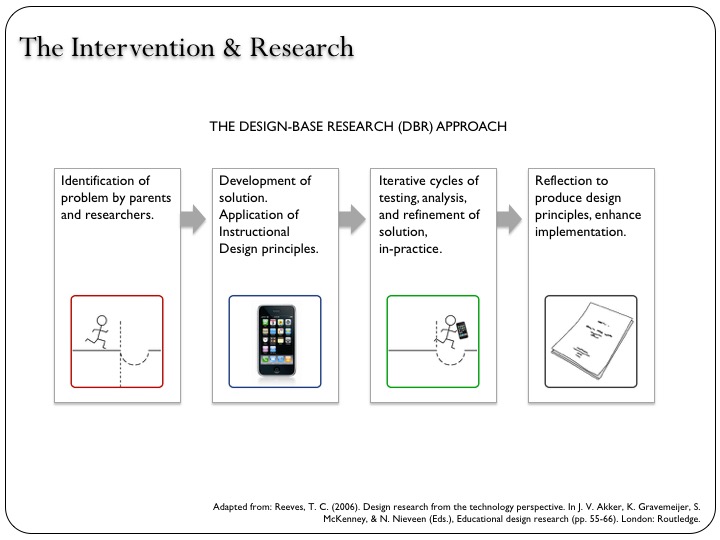 |
 |
| Figure 1: Design Model | Figure 2: Professional Credibility |
In each instance above, the author has made a decision about what kind of visual media would strengthen the message that is accompanied by written or oral communication. The audience assumes, for example, that the model in figure 1 is a true representation of best practice in user experience design for a mobile application. The audience assumes that the image used by the author in figure 2 does in fact show that the author has been an expert in his field for as long as he claims (the image might actually be an old image of himself doing something completely unrelated).
On the ethics of photo selection in photojournalism:
“When you are in media management, you hold the reigns not only to what information people get, but how they get it, in what order they see or hear it, and sometimes how they feel about it. ” – Katie McKay
As far as the audience is concerned, they trust that the author would only show something to them if it were true and accurate. Since the audience is not in a position to fact check every detail of a presentation as it goes along, they must depend upon the presumption of the author’s goodwill to sustain their involvement with the presentation or media.
The presumption of goodwill in the presentation of visual media is therefore directly associated with the author’s credibility. Exploiting the audience’s goodwill could lead to the complete dismissal of the author’s integrity.
Misleading graphical representation
The videos below demonstrate how graphical representations can be misleading.
Here is another collection of real world examples of statistical representations that were either intentionally designed to mislead the audience or were produced incompetently and no one conducted a quality control check:
ethical issues in rhetorical representation
Instances of ethical issues in advertising abound. Below are some examples that exploit goodwill or are gratuitously provocative.
American Apparel’s breach of moral standards related to the display of semi-nudity. The area of the article worth examining is the corporation’s justification that the design and display of the model was consistent with typical imagery shared on social media. The British Advertising Standards Authority felt that the images used in the ads were irresponsible and banned nearly all of them.
The freelance gig app, Fiverr, produced a series of print ads that were criticized as exploitative of the desperation freelance professionals feel in trying to find leads for their next job. Articles popped up that described how this approach was irresponsible.
An example of a print ad produced by Fiverr that received criticism for the appearance of exploiting the plight of freelancers.

In the example below, National Geographic was criticized for using an image of the pyramids at Giza, Egypt on its cover where they digitally manipulated them to move them closer together. This was done purely for a more aesthetic appearance. While this action was not intended to deceive readers in the same way a photo editor might change the color or shape of a person’s body, it promoted an inaccurate representation of reality. The backlash undermined National Geographic’s credibility.
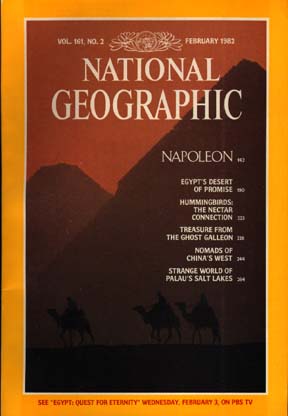
An image used by the University of Wisconsin for their 2001 course catalog considered a crowd shot for its cover but it did not appear to reflect the desired diversity of students. A Black student was photoshopped in to remedy this problem. The altered image is below on the left (look behind the student in the white sweatshirt). While it may be true that UW-Madison is diverse in the manner portrayed below, it was unethical for the media editors to consent to this practice just because an accurate image did not exist.
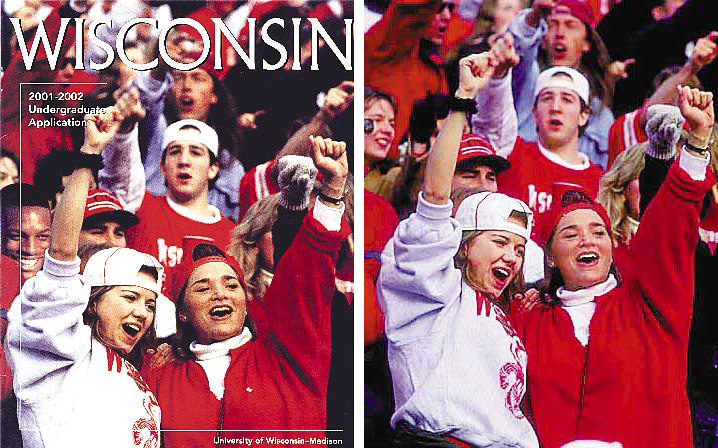
On the credibility of photojournalism in the digital photography and editing era:
“The fundamental fact that we usually forget is that when we take a picture we do not make a perfectly objective recording of reality rather what we make is an interpretation of reality…. Debate continues as to whether manipulated images, particularly those in magazines and newspapers, contribute to lack of credibility, integrity and believability of news media contents.” – Chinonye Faith Malizu (2011)
cultural and historical sensitivity in the choices of visual imagery
The production of visual media for an audience is a dialogue between the maker and viewer. There is a linkage between the author’s depiction of “what is” versus the viewer’s perception of “what ought to be.” The author produces a code that signifies a representation, imitation, or construction of what is real. This dialogue occurs within a social context, which is, in itself, a construction. When an author creates visual media, the product perpetuates a certain reality while contributing to an ongoing construction of what normal means (and, of course, what abnormal might be).
Authors of visual media may select the perfect image to use in a communication context only discover that the image has a particularly sensitive meaning to a group of people or a historical connotation that distracts from the intended message, often producing a negative effect. Visual imagery can unwittingly reinforce stereotypes, prejudices, power dynamics or inflame conflict over hot-button issues. Here are some of the areas of cultural sensitivity that are relevant to authors of visual media:
- The depiction of women, minorities, and members of ethnic groups in ways that reinforce stereotypical roles or profiles.
- The use of certain language or phrases that codify certain beliefs or power dynamics, or inappropriately co-opt the messages of an interest group.
- The reference to religious traditions or historical events that are “tone deaf” to the people who are faithful to those religions.
- The appearance of hegemonic relationships between different groups or people or nations.
- The historical legacy of slavery and colonialism in America, the Caribbean, and elsewhere.
- The presence or absence of diverse representation of people in the context of a “normal” environment: age, race, disability, body type, gender identity, etc.
Below are some examples of marketing efforts that failed to adequately research the potential insensitivity their messages conveyed.
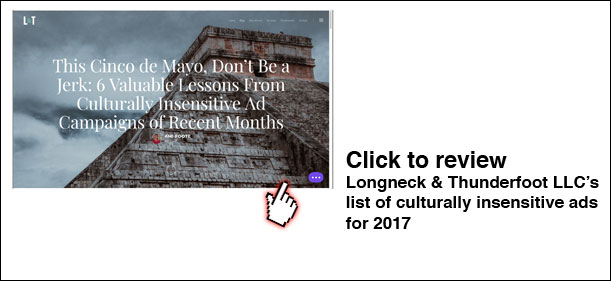 |
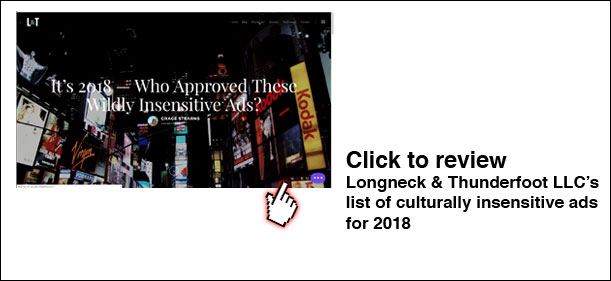 |
How do authors produce projects that align to cultural and historical sensitivity?
There are three basic perspectives to consider when producing visual media that align to codes of cultural and historical sensitivity (O’Donnell, V., 2004):
- Realistic Codes: The appearance, behavior, speech, and setting used to represent reality. How do you intend to portray reality?
- Representational Codes: The use of technologies to produce the appearance of the visuals. How do the affordances of technology affect the perception of context?
- Ideological Codes: The values, beliefs, attitudes, and behaviors that are associated with the norms of a society. How does the context and actions you portray conform to a particular social order?
Below are two of the examples presented by the Longneck & Thunderfoot LLC compilation from 2017.
 |
 |
| Fig. 1 – The GAP ad featuring Le Petit Cirque | Fig. 2 – Nivea ad campaign |
In figure 1, the criticism of this image is centered on the appearance of the tall white girl leaning on the head of the Black girl as if she were an object. Let’s apply the three codes of cultural analysis to the GAP ad:
Realistic Codes: Does the image portray a reasonably realistic appearance, behavior, speech, and setting for the given context? Overall, it plausible that these individuals would congregate together, so there isn’t anything particularly unrealistic being portrayed here.
Representational Codes: Does the use of technologies affect the perception of context in this visual? The photographic setting is located in a seamless studio. It is detached from a realistic physical environment such as a dance studio or school setting. But the seamless background, in itself, does not adversely affect the perception of the dynamic between the individuals, their respective cultures, or a historical connotation.
Ideological Codes: Does the image reflect a set of values, beliefs, attitudes, and behaviors that conform to a particular social order? In this case, the perception of the girls’ physical interplay, the racial components within that interplay, and the observable difference in the body language projected from each individual girl suggests a reality based upon an ideological code: the inferior status of Black people in relation to white people.
In figure 2, the Nivea ad, the elements of a cultural analysis are less abstract:
Realistic Codes: Does the image portray a reasonably realistic appearance, behavior, speech, and setting for the given context? Yes, there is nothing in particular about the image that is unrealistic.
Representational Codes: Does the use of technologies affect the perception of context in this visual? The colors and context are contrived for the purpose of controlling the aesthetics of the ad, but the photography and representation of the context do not affect the plausible portrayal of a woman seated on a bed looking out a window.
Ideological Codes: Does the image reflect a set of values, beliefs, attitudes, and behaviors that conform to a particular social order? In this case, the image itself is innocent, but the text of the ad, given the historical legacy of white supremacy in America, could be misconstrued to suggest that, while “white is purity,” things (or people) that are non-white are impure.
An overt example of Representational Codes in the world of selfie making
The Beauty Plus app is designed to retouch and reshape the user’s appearance according to a standard of beauty. There are clear ethical ramifications to the use of retouching one’s physical appearance with deceptive intent. On the other hand, “deception” in this manner may be a cultural construct that is more important in some societies but less so in others.
Authors of visual media must take into consideration that their work is a reflection of an individual’s cultural perspective. The selection of imagery in a given project will, for the viewer, suggest “what normal looks like” in a given context. For example, in depicting a business situation, how would a person of color feel about seeing a collection of business professionals who are all white? How would a woman feel about the representation of beauty in promotional material for clothes or makeup where her body type is never included?
As an author of visual media, you are privileged with the authority to determine who is included in your project and who is not.
An author’s best course of action should be to seek feedback and input from diverse sources before they “go live” with a publication or presentation.
OPTIONAL: Stock image search
Stock image repositories create libraries of realistic images that serve authors’ needs for images not readily available.
For example, if you were creating a tutorial on appropriate interpersonal interaction in a corporate environment, you would need several images of the same person (or people) in different business situations so that topics of the training could appear coherent.
The search process begins by logging in a professional stock image library and typing a search term. Let’s say you were searching for “accountant” and received a few pages of results. What does an accountant look like, from the perspective of “typical accountants you’d find in business situations”? Are they all white men, or are there men, women, people of color, varying ages, and varying mobility? What does a “real” accountant look like?
Take a look for yourself: Shutterstock’s library of accountants
Try another search on your own for something else, like firefighter, nurse, or “confident” (what does “confident” look like? What kind of person has confidence?).
Stock image libraries also need to consider the appearance of sarcasm or “only kidding” behaviors that could be considered insensitive. For example here is a search result for “frustrated man pointing to head” where the gesture is meant to convey a colloquial sense of a “just shoot me” situation. While this may seem completely innocuous, for millions of people affected directly by suicide (either in an attempt on taking their own life, or in experiencing an attempt or death by suicide of someone they know), the gesture appears to trivialize their lived experience.
References
Barry, A. (2004). Perception Theory. In Smith, K. L., Moriarty, S., Kenney, K., & Barbatsis, G. (Eds.), Handbook of visual communication: Theory, methods, and media. Routledge (pp. 45-62).
Malizu, C. F. (2011). Re-examining the credibility of photojournalism in the digital photography and editing era. Benin Mediacom journal, 1(4), 133-148.
O’Donnell, V. (2004). A Cultural Analysis of the Unisys “Monitor Head” Television Commercial. In Smith, K. L., Moriarty, S., Kenney, K., & Barbatsis, G. (Eds.), Handbook of visual communication: Theory, methods, and media. Routledge (pp. 45-62).


